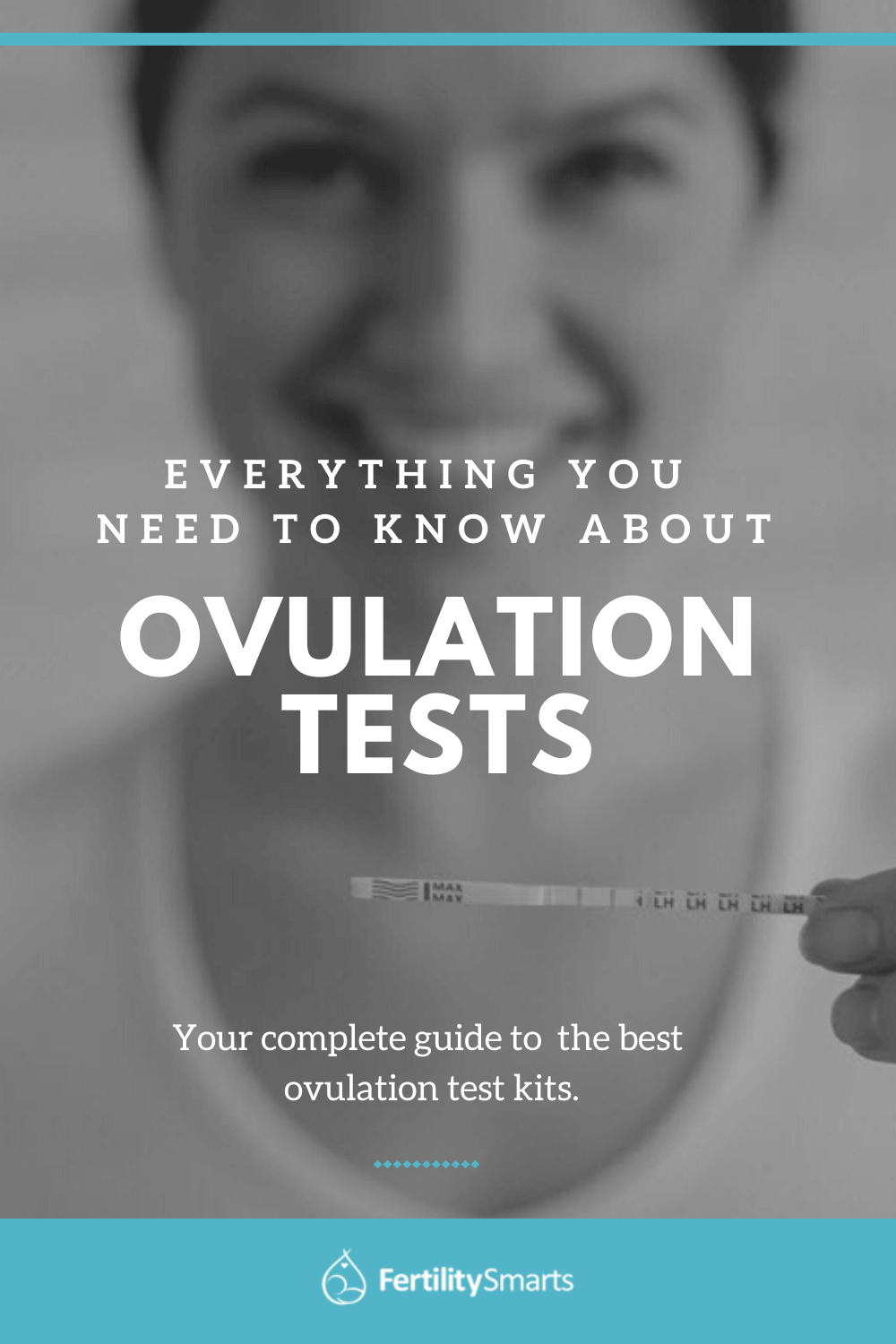If you are looking to get pregnant quickly (and both partners have no underlying fertility issues), timing is the key.
The optimal time to conceive is called your fertile window. Peak fertility or ovulation is not standard across all cycles. This means that accurately predicting ovulation is individual. Even those with regular cycles can have highly variable timing of their fertile window.
Because of this, determining ovulation based on a calendar method or calculations (assuming ovulation is day 14 or dividing the length of your menstrual cycle by two) is not necessarily accurate. Monitoring physical symptoms can provide you more information about the actual timing of your fertile window.
This is where an ovulation test kit can be useful. To understand precisely how ovulation tests help, it's helpful to understand what exactly is meant by your fertile window.
Identifying Your Fertile Window
There are only certain days of a menstrual cycle where conception is possible. This 6-day timeframe is referred to as a “fertile window” and includes the five days preceding ovulation and the day of ovulation itself.
This time period is determined by adding together the maximum possible viability of both the sperm and egg.
When an egg is released, it must be fertilized within 12-24 hours, or it is reabsorbed back into the body. Sperm can live inside of the female reproductive tract in the right conditions for up to 5 days. Together, the possible range for fertilization to occur becomes this 6-day fertile window.
Which days are you most likely to get pregnant?
While pregnancy is possible over these 6 days, it is most likely to occur during the two days preceding ovulation and the day of ovulation itself. In a study of 221 women, couples who had sex once during this three-day timeframe had a 27% to 33% chance of becoming pregnant.
The study reported that the likelihood of becoming pregnant if you have sex during the fertile window was as follows:
- 5 days before ovulation – 10 %
- 4 days before ovulation – 16 %
- 3 days before ovulation – 14 %
- 2 days -before ovulation 27 %
- 1 day – 31%
- Day of ovulation – 33%
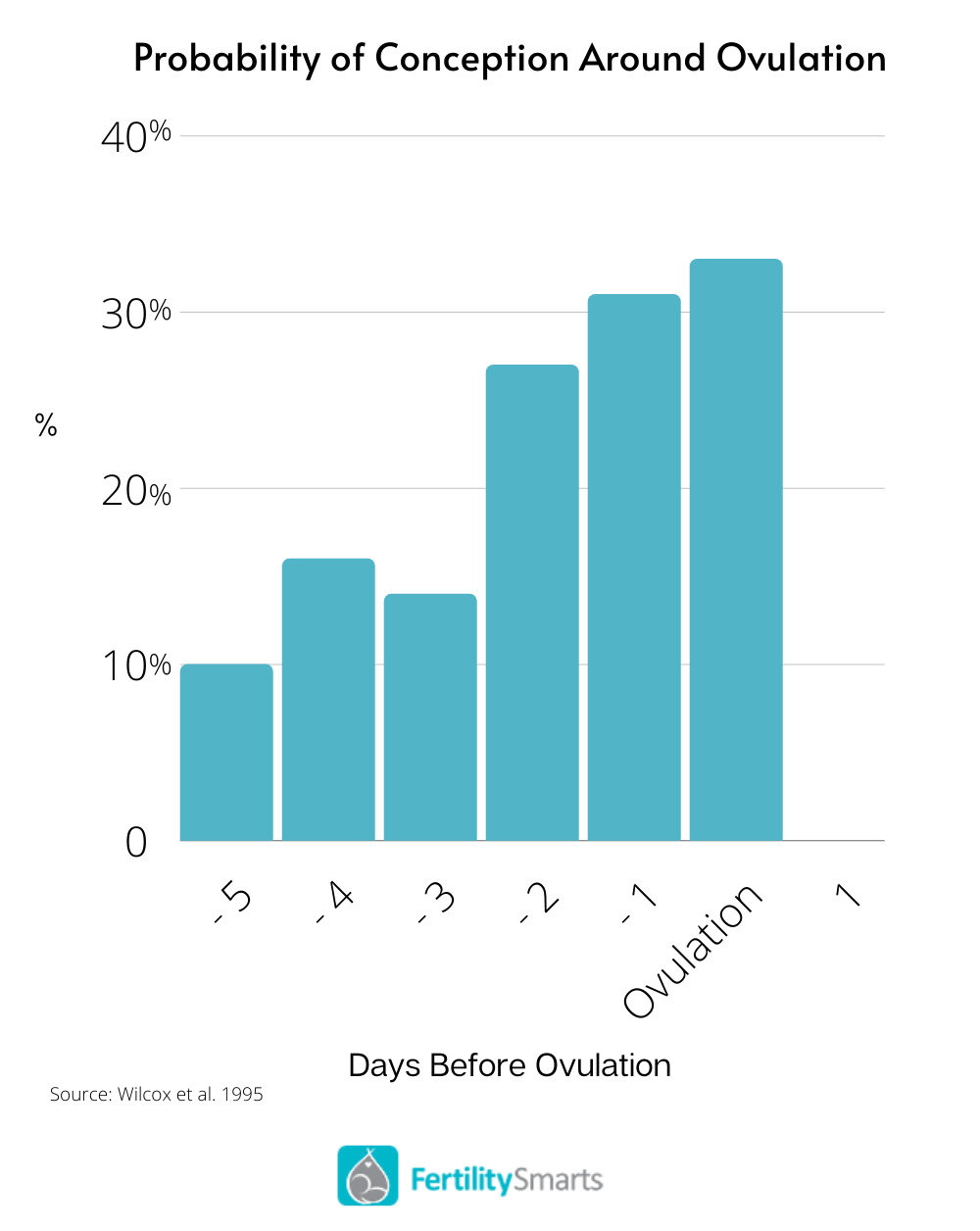
Another study shows that sex on the day before ovulation is most likely to translate to pregnancy and that chances of conception drop dramatically to almost 0% after ovulation.
Bottom line: There is a 6-day window that consists of the five days before ovulation and the day of ovulation itself for the fertile window where pregnancy is possible. Of these days, the final two days and the day of ovulation have the highest probability of conception. (Read about fertility-friendly lubricants)
Don't I Ovulate on Cycle Day 14?
The clinical guidelines have long been that a median menstrual cycle is 28 days with a steady 14-day luteal phase (number of days after ovulation until the next period), meaning that ovulation is generalized to occur on day 14.
There is much more variation among cycles, meaning that this would not be the most accurate way of determining your fertile window. In a large study, the mean menstrual cycle was 29.3 days, and follicular phase length, or ovulation date, was 16.9 days. Only around 13% of cycles were found to be 28 days long.
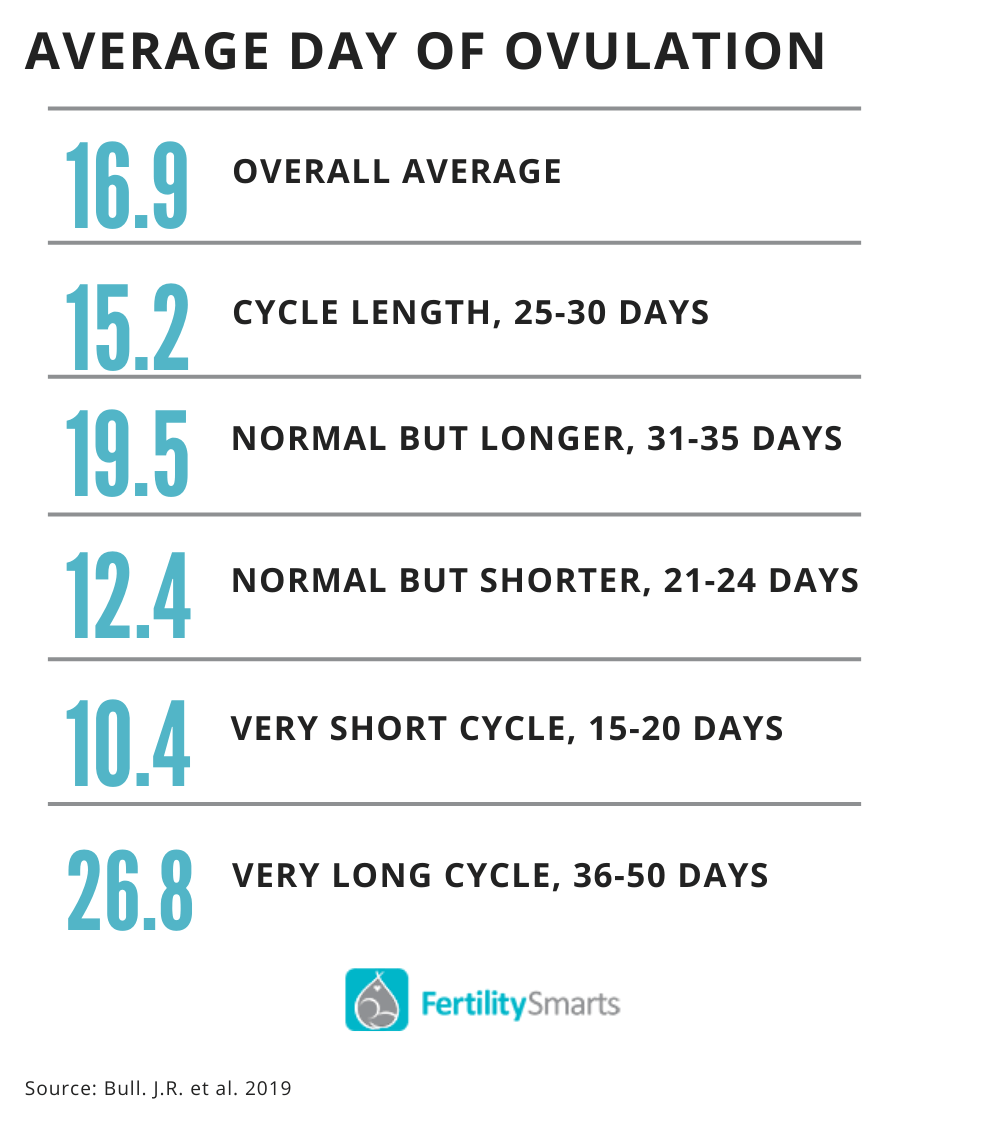
One study found that women seeking treatment at fertility clinics had attempted to identify their fertile window, but few could do it accurately. The researchers concluded that a lack of fertility awareness can cause problems when trying to get pregnant and might be a contributing cause of infertility.
Online Ovulation Calendars
What about those free online ovulation calendars? Most online ovulation test calculators that "calculate" your fertile window with only your cycle length likely use the day 14 assumption. We know that not everyone ovulates on day 14, making these results not accurate for many people. More accurate results come from interpreting signs from your own body through fertility awareness or luteinizing hormone (LH) ovulation tests.
Read:
Implantation Calendar: What is Happening During the Two-Week Wait?
What is an Ovulation Test?
A basic ovulation test can be done at home and will help you predict when your body will release an egg through the process of ovulation. By identifying when you ovulate, you can time sex for the best chance of getting pregnant.
How Do Ovulation Tests Work?
Most urine-based ovulation predictor tests work by detecting the amount of luteinizing hormone (LH) present in urine. A surge of this hormone triggers a follicle to release an egg, and detecting this surge can be used to predict ovulation. A surge of LH means that the chances are high that ovulation is coming up.
Standard LH Ovulation Tests


The majority of tests on the market fall into this category. They are either a strip (or dip) test where a test strip is dipped into a cup of urine or a midstream test where a test stick with an absorbent tip is held in the urine stream (think pee-on-a-stick).
- All of these tests are qualitative or threshold, which means that a certain hormone level will trigger a positive result. The threshold is often 25 mIU/ml or 40 mIU/mL (mIU/mL is the abbreviation for the measurement milli-international units per milliliter.)
- Because they are threshold-based (yes/no), these tests don't work well for people with atypical hormone patterns, including polycystic ovary syndrome (PCOS), symptoms of menopause, or those taking some fertility-enhancing medications.
- The user interprets the results by how dark a line is compared to a test line. The more of the hormone present, the darker the line will appear.
- The tests tend to be in a lower price range.
Digital Tests

With digital tests, a test stick is inserted into urine and then entered into a mini-computer that analyzes the sample and displays the results.
- The main advantage of digital tests is the results displays on a screen, and there is no interpretation involved.
- Even though these tests are more sophisticated, they are still qualitative/threshold and are triggered by a certain concentration of the hormone.
- Some kits also test for estrogen, or E3G, which is produced when estrogen breaks down and is found in urine around ovulation. Because E3G increases before LH, it can provide more days of a fertile window.
- These tests are generally in a mid-to-high price range.
Fertility Monitors
While not all monitors work the same way, they typically track multiple cycles and use the cumulative info to predict your fertile days.
- The results are interpreted for you and displayed on a digital screen.
- Some monitors work well for people with hormone imbalances.
- These monitors are generally more expensive.
Best Ovulation Test
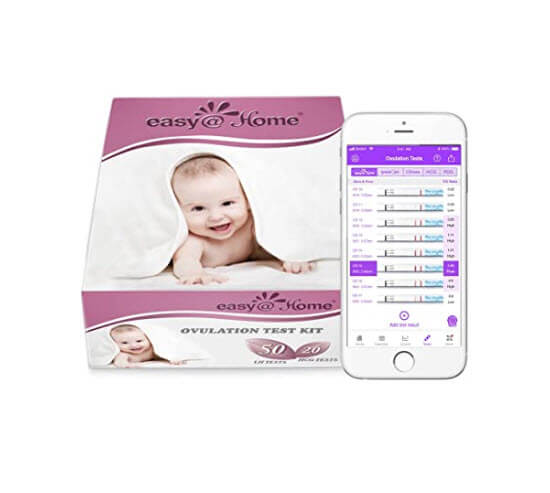

Best Ovulation Strip Test—Easy at Home Ovulation Test Kit
If cost is your primary concern, Easy@Home Ovulation Test Kit is your pick. This is a basic strip test that detects an LH surge in urine—nothing fancy here. But if the test style (detecting a line darker than the control line) works for you, you can’t beat the price.
Depending on the quantity, you can purchase these strips for approximately $0.18 per test.
Easy at Home Ovulation Test Review
What we like:
- 9-Cycle Money-Back Guarantee. It’s a complicated process, but Premom will refund the cost of eligible easy@home ovulation and pregnancy tests if you don’t conceive within 9 months.
- There are 50 test strips if you are a frequent (or long-term—so sorry) tester.
- Bonus: 20 pregnancy strips included.
Considerations:
- Strip ovulation tests require more effort to interpret the results.
- If you want disposable urine cups, you need to purchase them separately.
- The Premom app that can be used to track the results of this brand of tests has been scrutinized due to a breach of privacy concern where personal data was allegedly shared without user consent.
- People with PCOS approaching menopause on fertility-enhancing drugs may not get accurate results using just the strips.
How to read the results:
What does a positive Easy@Home Ovulation Strip look like? When the test line is as dark or darker than the control line. Easy@Home also indicates that the darkest line from consecutive testing in one cycle can also be peak fertility.
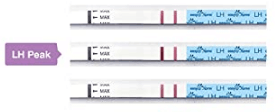
Buy on Premom.com | $21.99
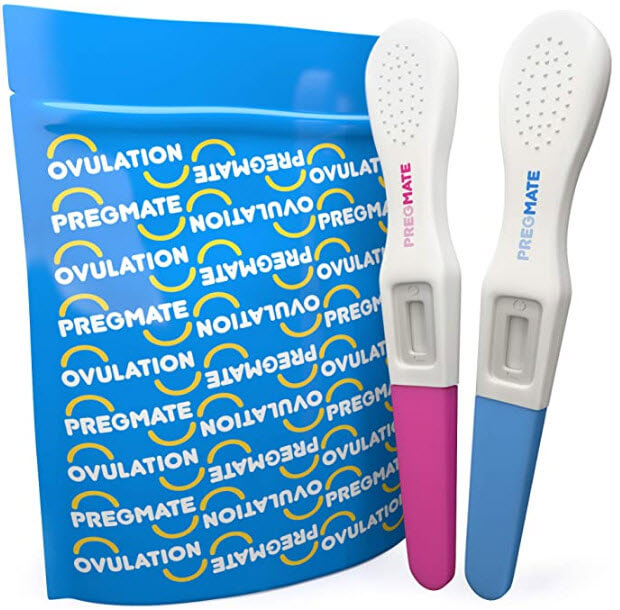
Best Midstream Test – PREGMATE Ovulation Predictor Kit

Need to test your LH while you are at work or out of the house? This PREGMATE OPK is a two-line, midstream test (think pee-on-a-stick), making it collection cup-free! That's about as public bathroom-friendly as it comes. This kit comes with 20 test sticks and 5 pregnancy tests.
Expect to pay around $0.88 per test.
PREGMATE Ovulation Test Review
What we like:
- It’s quick—hold the absorbent tip of the test in urine for 10 seconds, and you can read your results in 3 minutes.
- 5 bonus pregnancy tests.
- A decent price point for a midstream test.
Considerations:
- Need to interpret peak fertility by detecting the test line as dark or darker than the control line.
- The number of tests included in a single package is likely only good for 1 or 2 cycles.
- No PREGMATE tracking app to record results.
- People with PCOS, those approaching menopause, or on fertility-enhancing drugs may not get accurate results.
What will a positive ovulation test look like?
A positive PREGMATE ovulation test has the test line (T) is as dark or darker than the control line (C):
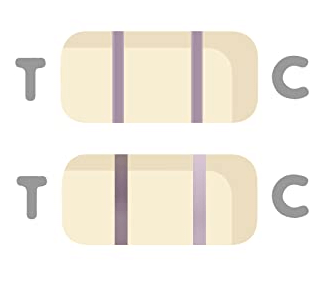
Buy PREGMATE Ovulation Tests:
Buy on Amazon | $21.95
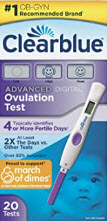
Best Digital Ovulation Test: Clearblue Advanced Digital Ovulation Test

The Clearblue Advanced Digital Ovulation Test is a midstream test with a digital display, meaning there is no need to interpret results: no surge detected (circle), surge detected (flashing smiley face), or peak surge detected (smiley face).
It is foolproof to use, and the results couldn't be clearer. Because of this, it is our #1 suggested test if you want a clear answer that doesn’t involve two lines. As you may expect, convenience is also pricey. You can expect to pay around $2.00 per test. (See our breakdown of other Clearblue tests below.)
Our Review
What we like:
- If you have no interest in tracking a progression of lines getting darker, this is for you.
- If you have test anxiety and need to know if you have done it correctly, this is for you.
- Tracks estrogen and LH. Estrogen rises before LH, which gives more days of the fertile window.
Considerations:
- There is no tracking app.
- People with PCOS, approaching menopause, on fertility-enhancing drugs may not get accurate results.
- You need to purchase a whole new unit to get more test sticks. (Refill sticks that you can find are for the ClearBlue Fertility Monitor and will not work with this product.)
Buy Clearblue Digital:
Buy on Amazon | $39.98
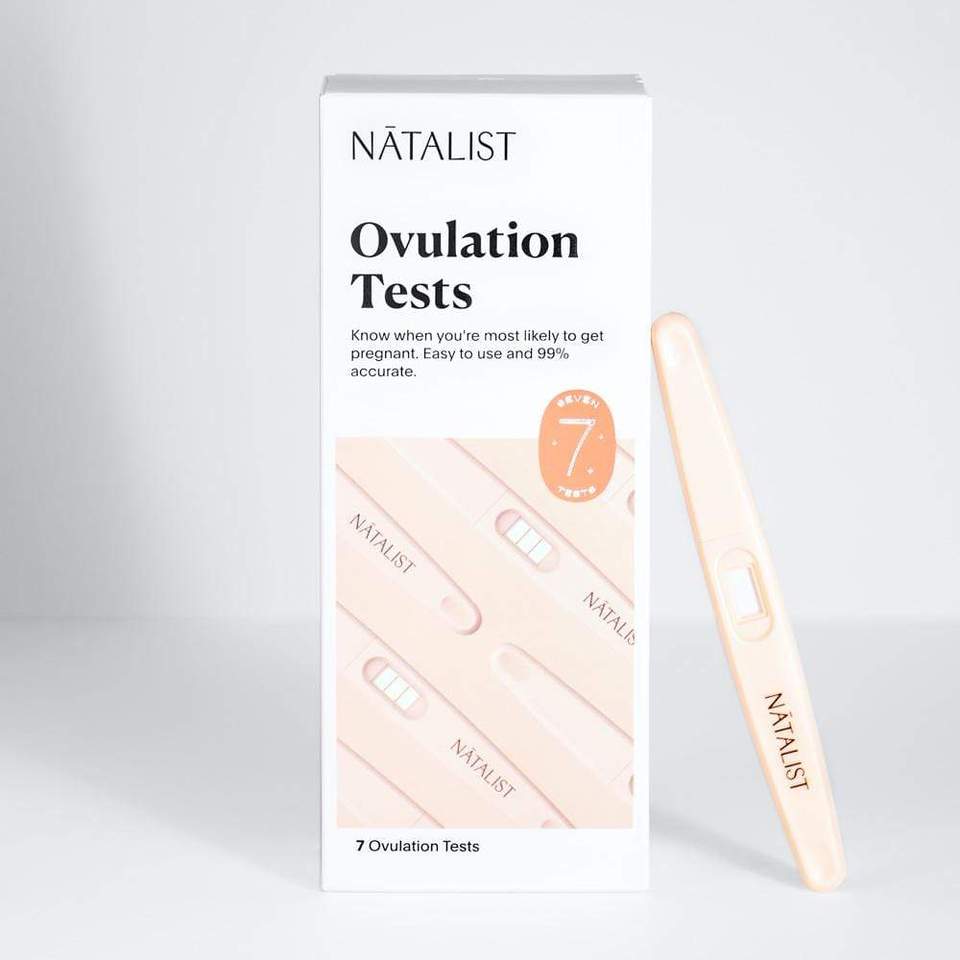
Best Conception Bundle

Natalist offers a midstream test to tell you if you have elevated LH or not (qualitative test). The test is read by looking for two colored lines where the test line is dark or darker than the control line.
What makes Natalist unique isn’t so much this single test, but that they are out to change the conception experience by offering several well-designed products in one stop. We like their Get Pregnant Bundle that includes everything you need to get started trying to get pregnant, including ovulation and pregnancy tests, prenatal vitamins, fertility lubricant, and a Conception 101 book.
The tests can cost as low as around $0.89 per test when purchased in bulk.
Our Review
What we like:
- Plastic neutral: Natalist facilitates the removal of plastic pollution for each pound of plastic that they sell.
- Significant price discounts when you purchase in bulk.
- Get all of your conception products in one order.
Considerations:
- No app to digitally track your results.
- One box is 7 tests, which may not be enough for a single cycle. If you have a longer cycle, make sure to purchase multiple boxes.
- Because it is testing for LH, people with PCOS, approaching menopause, or some fertility-enhancing drugs may not get accurate results.
Buy Natalist Ovulation Tests:
Buy on Natalist.com | $18.00
(Save 10% with code: FertilitySmarts)
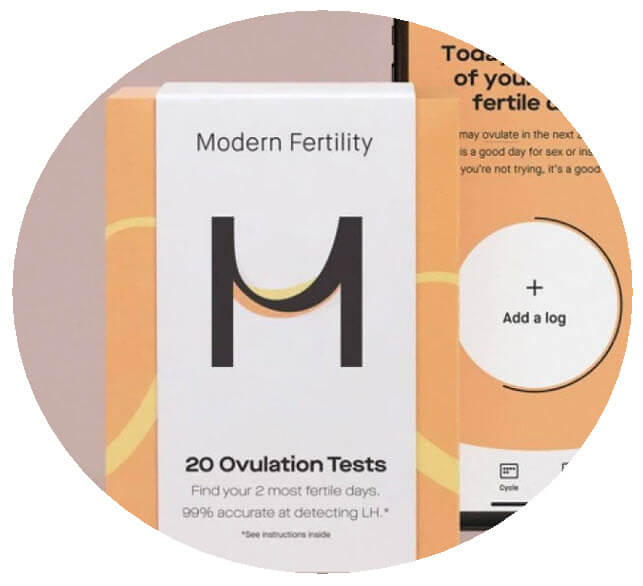
Best Ovulation Tracking App: Modern Fertility

Modern Fertility Ovulation Tests are strip-based tests that can determine your two most fertile days. The test can measure low, high, and peak LH by comparing your results to a color bar on the test package. If you’ve ever felt frustrated trying to decipher the shade of a test line (is this peak?), then this is the test for you.
If a tracking app is at all important to you, this is also our pick. For an ovulation tracking app to really work, it needs to have some physiological info from your body. Modern Fertility has done just this by creating the easy-to-use Modern Fertility App that can track your test strips by using your phone camera to scan them. The app will also help you interpret test results and predict future fertility.
Tests can cost as little as $0.80.
Our Review
What we like:
- The (excellent) app is free.
- Clear, plain language instructions.
Considerations:
- Urine cups are not included. You can order them from Amazon.
- As an LH test, people with PCOS, those approaching menopause, or on fertility-enhancing drugs may not get accurate results.
Buy Modern Fertility Ovulation Tests:
Buy on Modern Fertility | $16.00
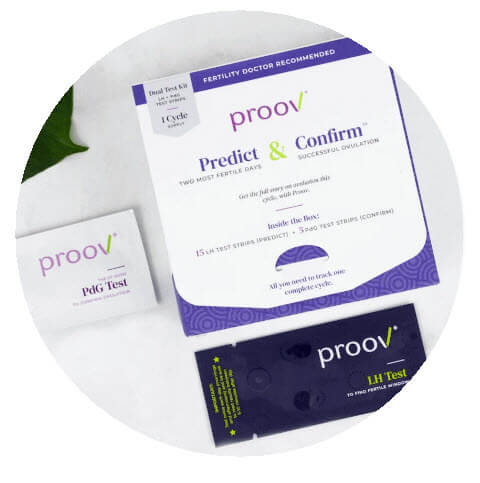
Best Ovulation Confirmation Test – Proov

How do you know if you’ve ovulated? Proov test strips can be used to answer this question. Progesterone is a hormone that is released by the ovary around 24-36 hours after ovulation. Proov can detect PdG, a marker of progesterone, found in urine. This test does not predict ovulation but confirms it has occurred.
This likely isn’t the test for someone with a typical menstrual cycle who is just starting, but if you’ve been trying unsuccessfully for a while or want to make sure you are ovulating, this is a relatively affordable and easy test. Not getting a consistently positive result with Proov likely indicates follow-up with a medical professional.
If predicting ovulation and confirming ovulation is what you need, Proov offers a Predict & Confirm Kit that comes with 15 LH (predict) test strips and 5 PdG (confirm) test strips.
Our Review
What we like:
- It isn’t a huge investment to confirm ovulation.
- Progesterone deficiency can be a cause of unexplained infertility or pregnancy loss. Being able to test helps you advocate for your concerns.
- Works for people with PCOS who want to confirm ovulation.
- Proover Community is a private Facebook Group to connect with others with similar concerns.
- We can help you save $5 off your order.
Considerations:
- Unless you also use LH strips, a PdG test is positive after ovulation, so it won’t help you get pregnant the cycle you use it.
- Knowing your cycle can help make more efficient use of the PdG strips.
- Some reviews mention confusion when reading results, but there are good resources to help (see below).
What do Proov test results look like?
A positive Proov Test shows as a single line. It does not work the same way that LH or hCG test work, where you expect to see two lines.
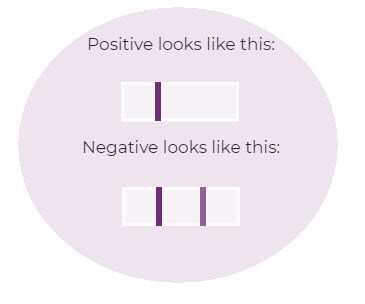
Buy on Proov.com | $29.99
(Save $5 with this link)
Fertility Monitors
Mira Fertility Tracker
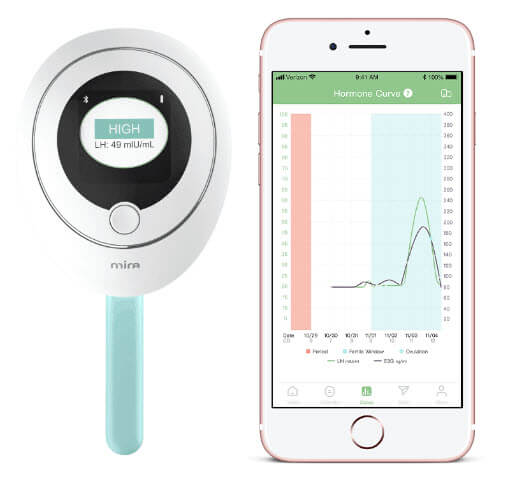
Mira Fertility Tracker is like having a mini-lab in your house. It measures actual hormone concentration levels to identify your personal fertile window of up to 6 days. This means you get a reading with the actual number of mIU/ml rather than only detecting if it meets a certain threshold (did a dark line appear or not), like many other tests.
This can detect your personal hormonal pattern for people who don’t have a typical hormone pattern and get unreliable results with typical urine LH OPKs.
If you are looking to determine (not estimate!) when you actually ovulate, this tracker can also do that too.
How to use Mira: A test wand is inserted into a cup of urine for 10 seconds and then into the Mira Analyzer, and the hormone concentration results are synched with the Mira App. The algorithm within the Mira App estimates your fertile window and confirms ovulation after the fact.
Top-notch functionality does come at a higher price point, but endless boxes of drug store tests can add up, too. If you want no doubt or if you’ve been frustrated trying to identify when you ovulate, we think that this is the most comprehensive LH-based ovulation test out there.
The Mira analyzer comes in a Fertility Starter Kit or Fertility Starter Kit Plus. The difference between the two kits is the type of wands included:
- Mira Fertility Wands measure actual LH concentration levels. It can detect a fertile window of up to 4 days.
- Mira Fertility Wands Plus measures actual concentration levels of LH and Estrogen (EG3). Because EG3 is detectable before LH, it can identify a longer personal fertile window of up to 6 days.
Our Review
What we like:
- Automatic Bluetooth means not trying to find a cord to sync the Mira Analyzer to the Mira App manually.
- Lab-quality results provide the ability to track what is happening with your cycle and take that info to a medical professional for further discussion.
- Money-Back Guarantee – A full refund is available if you don’t find an LH surge after 3 months.
- We can save you $25 off a starter kit (code: fertilitysmarts)
Considerations:
- You need to purchase upgraded Plus Wands to measure estrogen.
- You will also need to purchase additional test wands, making it more than a one-time cost. Starter kits come with 10 wands, and approximately 10-20 test sticks are needed per cycle.
OvuSense
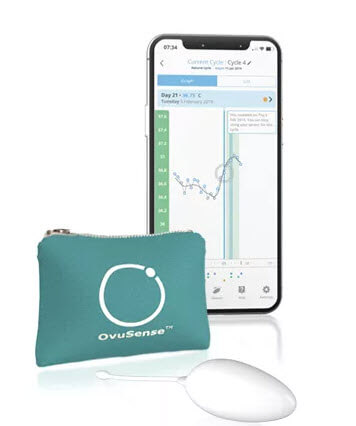
OvuSense is a vaginal sensor that uses core body temperature to estimate your fertile window. It can predict ovulation within 24 hours (96% accuracy) and confirm when it occurs (99% accuracy). It basically provides a combo of urine-based LH ovulation tests and BBT tracking in one device.
How it works: The device measures and tracks progesterone fluctuations through changes in core body temperature. The lowest temperatures occur during the fertile window, and after ovulation, progesterone causes a peak in temperature. The egg-shaped device is inserted like a tampon and collects data while you sleep. In the morning, the data is synced and downloaded into the OvuSense App, where it informs the algorithm that predicts and confirms ovulation.
OvuSense offers 3 starter packs ranging from $129 to $449, and subscription extensions (required) range from $35-$360.
Review Summary
What we like:
- Because it does not depend on LH, it can work for people with PCOS, diminished ovarian reserve (DOR), or taking certain fertility drugs that may get skewed results from tests that analyze LH alone.
- There is a learning curve to BBT fertility charting that this device can eliminate.
- Ideal if you want ongoing awareness of your fertility.
- We can save you 20% off of standard OvuSense with the code: FERTILITYSMARTS20
Considerations:
- You need a paid subscription to download data from your sensor (2 months free with a standard plan).
- Your sensor has a life of one year. You would need to purchase a new unit to continue beyond 365 days.
- The device (even if comfortable) needs to be inserted vaginally at night consistently.
Save 20% on OvuSense Standard
Ava Fertility Tracking Bracelet
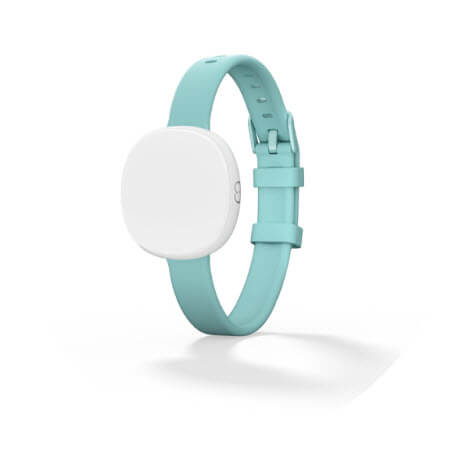
Ava is a bracelet that is worn overnight that records several physiological parameters (pulse, skin temperature, heart rate, breathing rate, perfusion/blood flow) that then is synced with the Ava app that uses an algorithm to determine your 5-day fertile window.
We think of this as fertility tracking lite. It’s perfect for users who are looking for a way to identify their general fertility window comfortably with minimal effort. If you want awareness without the nitty-gritty, this is for you.
How it works: The bracelet collects data as you wear it overnight. In the morning, you synch your bracelet with the app, and with enough data, the algorithm spits out your 5-day fertile window.
Along with fertility, the Ava app can also track periods and pregnancy.
Review Summary
What we like:
- Tracking fertility can be a stressful process. Ava provides enough information for a general understanding of your fertile window with minimal commitment.
- Upgraded packages offer a refund if you don’t get pregnant within 6/12 months.
- It’s a one-time purchase; no additional costs to continue using the tracker.
Considerations:
- If you have a cycle length that varies significantly (outside of 24-35 days), this is not a product recommended for you.
Buy Ava
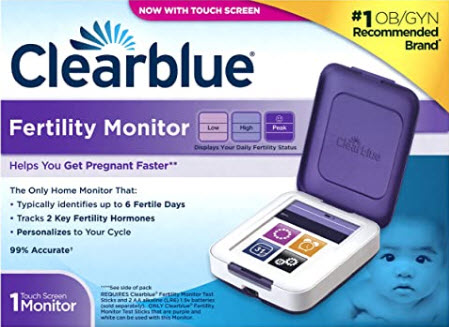
Clearblue Fertility Monitor is a touchscreen unit that can test LH and estrogen levels and displays up to a 6-day fertile window with a high and peak day.
How to use: After the initial set-up, the calendar in the monitor needs to be checked daily to see if it is a test day. On a test day, a single-use test stick is immersed into urine and then inserted into the monitor. The results that appear on the screen will indicate your fertile window: low, high, or peak. Plan on testing 10-20 times each month. With separate test sticks, it can be used to test for pregnancy, too.
We like anything that gives people more info about their fertility, but for the price point, you should be aware this really isn’t a sophisticated device. The limitations for us included:
- We prefer the convenience of tracking through apps on our phones and not a separate unit.
- The calendar display and cycle summary display screens are crowded.
- You are only able to track 6 previous cycles.
- This is still a threshold test (triggered by a certain concentration) that displays low, high, and peak, similar to digital ovulation tests.
Clearblue Ovulation Test Review
Clearblue is a popular brand of ovulation test that you’ve likely seen stocked at your local store. They offer several different products, and the packaging and product names are very similar. So how do you know what to buy?
- Fertile Days Detected. Tests that analyze both LH and estrogen will predict more days of a fertile window than tests that are just LH.
- Digital Display. Tests offer clear results with no interpretation.
- Digital Tracking. Keeps track of the results of multiple cycles.
- Refill Test Sticks. None of these tests have refill sticks. You need to purchase a new unit.
Threshold Test. All of these tests give a yes/no answer and are not ideal for hormone imbalances.
The Clearblue Ovulation Complete Starter Kit has 10 midstream tests and 2 pregnancy tests. This is the most basic pee-on-stick test that Clearblue offers. This is not a digital test. The detection of an LH surge shows when two dark lines appear. You will need to determine when the test line is darkest.
The Clearblue Ovulation Test Digital kit has 20 test sticks and a digital reader. It detects LH levels to pinpoint your 2 most fertile days. The test screen will display two settings: a circle for no surge and a happy face when a surge is detected. This test is straightforward, and no interpretation is needed.
Clearblue Advanced Digital Ovulation kit has 20 test sticks and a digital reader. Because it detects LH and estrogen, it can identify 4 or more fertile days. It is different from the digital test listed above in that it displays 3 settings: a circle for no surge, a happy face that flashes when LH is high, and a constant smiley at peak fertility. Identifying peak fertility maximizes your chance of pregnancy. This test is easy to use and interpret.
Clearblue Connected Ovulation Test System Featuring Bluetooth comes with a digital reader and 40 test strips. The reader detects LH and estrogen. It displays 3 settings: a circle for no surge, a happy face that flashes when LH is high, and a constant smiley at peak fertility. Identifying peak fertility maximizes your chance of pregnancy. It also has a Bluetooth connection that you can sync the digital reader to the Clearblue app. The automatic sync and storage into the app is a fantastic feature, but there are some complaints that the connection process isn’t always seamless. Also, we think that the app itself is mediocre in its usability. We like that this unit comes with 40 test sticks because, again, you cannot purchase additional test sticks separately.
Ovulation Questions & Answers
What does a positive ovulation test mean?
A positive result means ovulation will happen within approximately the next 12-36 hours and almost always within 48 hours. The best time to have intercourse is usually the day after the first positive test.
What are the chances of getting pregnant after a positive ovulation test?
There really isn't a good answer question because all bodies are different. If you are testing perfectly with no results, know that for couples who are young and have normal fertility, the chance of getting pregnant is between 20% and 37% during the first 3 months. Ovulation tests can help time intercourse but aren't a sure thing.
When is the first day of a surge likely to be?
In one study that examined the characteristics of LH surges in 283 cycles, the median cycle day of onset of an LH surge was 15, with a range between day 8 and day 25.
When should I take an ovulation test?
It is recommended to start checking a few days before the expected surge. On average, most women should start testing for ovulation between days 9-11, but this is variable depending on menstrual cycle length.
The best time of day to check OPKs is usually mid-afternoon to early evening as the LH surge occurs in the bloodstream early in the morning and then is detectable in the urine several hours later. It is ideal to test around the same time each day.
Does a faint line on an ovulation test mean positive?
Ovulation tests are not like pregnancy tests where any line indicates a positive. A faint line does not indicate a positive result for an LH test. Read the instructions for your specific brand; for some kits, the test lines need to be at least the same color as the control line, and for others, the test line needs to be darker than the control line.
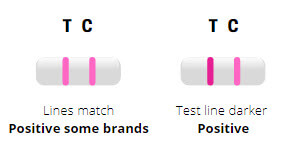
Can an ovulation test be positive for several days?
The midcycle LH surge is brief, usually lasting for about 48-50 hours, with ovulation usually occurring about 36 hours later. This means you can get a positive ovulation test two days in a row.
Can you have positive ovulation tests twice in one month?
While uncommon, some cycles have multiple LH surges. They may be referred to as a double peak or multiple-peak LH surge. It is possible to have multiple follicular stimulations.
This means that your body releases a follicle that does not rupture and subsequently releases a second follicle. With multiple peaks, it is typically the last peak typically indicates ovulation.
When is the best time to have sex after a positive ovulation test?
The best times to have intercourse after a positive ovulation test are the day of the positive and the next two days.
Can I rely solely on ovulation tests for timing intercourse?
Test strips will give you 12-36 hours heads up that ovulation is approaching, but this means that it is possible to miss peak days of cervical mucus by underestimating the fertile window while waiting for a positive OPK test. It is ideal to have sperm waiting in the reproductive tract when ovulation occurs.
Tracking your cervical mucus and watching for egg white-like consistency is still a good idea. This is a sign of high fertility. Measuring your basal body temperature (BBT) can also give you more information regarding when ovulation occurs. Even though BBT signals ovulation retrospectively, it can show which cycle day ovulation occurred.
How accurate are tests?
Assuming correct usage, most tests will say up to 97% to 99% effective. Test results are sensitive to both the volume of fluid intake and the time of day the test is performed. Check the expiration date of the product you are using.
What can create a false-positive result with ovulation tests?
It is possible to get unreliable results when certain fertility drugs such as Pergonal, Danazol, or an hCG trigger shot (Profasi). If you are taking Clomid, you can use the tests, but you need to consult your doctor for the best time to start testing.
- Women over 40, particularly if approaching menopause, may have an increase in LH at all times, meaning the test is inaccurate.
- If you have recently been pregnant.
- Having polycystic ovary syndrome (PCOS).
Do ovulation tests work if you have PCOS?
People with PCOS may experience false positive ovulation tests because they already have high LH levels. Polycystic ovaries contain follicles that house eggs that didn't develop properly.
The gist: Because PCOS is a hormonal disorder, tests that read LH hormone may provide inaccurate results.
Does a positive test mean you've ovulated?
The short answer: no. A positive result means that your body is trying to ovulate. It is possible for an egg to be released and trigger an LH surge but not make it into the fallopian tube.
It is also possible that an egg fails to release from a follicle after an LH surge provides the signal. This is known as luteinized unruptured follicle syndrome (LUFS).
Can you ovulate but have no LH surge?
The answer is no. LH is required to release a mature egg. It is possible to miss the detection of an LH surge, but you cannot ovulate without a surge.
One study found that there was considerable variation in the length of LH surges. Out of 281 cycles, the mean LH surge duration was 4.8 days with a range of 1 to 16 days.
What if you don't get a positive ovulation test?
It may be possible for ovulation not to occur during a cycle. If you notice two or more anovulatory (no ovulation) cycles, it may indicate an issue with ovulation that requires evaluation by a medical provider.
Will an ovulation test be positive if you are pregnant?
No, a basic ovulation test cannot detect a pregnancy. A urine-based ovulation test detects luteinizing hormone (LH), a reproductive hormone that triggers ovulation. A pregnancy test detects human chorionic gonadotropin (hCG), a hormone produced in early pregnancy. A urine-based ovulation test that is not designed to detect hCG cannot test for pregnancy. You definitely want a pregnancy test to test for pregnancy.
